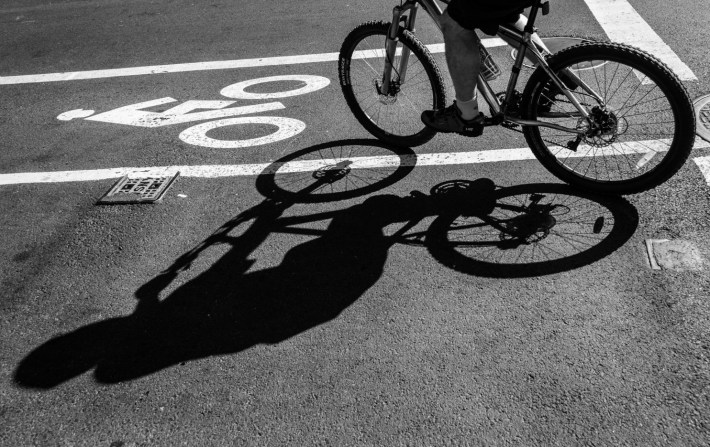Cross-posted from the Alliance for Biking and Walking.

It started as a lively discussion on the Bike Equity Network — a listserv for mobility and equity advocates working within walk/bike advocacy and planning — related to a Washington Post article that examined the notion of bike lanes as symbols of gentrification. The online conversation that transpired was rich, frank, and underscored the need to bring the conversation to a broader audience in a more interactive format. So this month, the Alliance hosted a highly anticipated Distance Learning Webinar: “Active Transportation & Anti-Displacement.”
Co-facilitated by Dr. Mike Smart, Assistant Professor at Rutgers University, and featuring insight from several equity leaders, the webinar was a timely and candid conversation that provided Alliance members an opportunity to hear diverse perspectives from and ask questions of advocates working within academia and advocacy — and future planners in Dr. Smart's class.
Special thanks to Dr. Mike Smart, as well as our presenters:
- Dr. Adonia Lugo, Bicicultures
- Anthony Taylor, Adventures Director at The Loppet Foundation and National Brotherhood of Cyclists
- Tamika Butler, Executive Director, Los Angeles County Bicycle Coalition
Listen to the full recording on SoundCloud here and read a summary of the main takeaways below. Also catch some of the conversation that happened on Twitter via hashtag #MobilityEquity. Enjoy!
Acknowledge that bicycle infrastructure is wrapped up in larger development processes spurring gentrification, which has in many cases been done on purpose.
Urban development and re-development strategies employed in cities and towns across the U.S. over the last decade have spurred the erasure of communities, culture and the displacement of low-income and communities of color, and these strategies have included bike infrastructure. By acknowledging this, bike/walk advocates and planners can begin to be allies and address anti-displacement strategies.
Engage people and communities in a real way.
Transportation planning and urban planning in the U.S. have a long tradition of excluding communities, particularly low-income and communities of color, in its processes. This has yielded social and racial inequities — and a deep distrust in many communities. Therefore, it’s important to engage communities in a real way. Be ready to listen and not talk about bikes or push your agenda at meetings. Figure out ways you can support a community's agenda through your leverage as an advocate or planner. And once a real relationship has formed, then engage people, give them a seat and vote at the decision making table, not simply a token invitation to diversify a room. Give people the power to make informed decisions about their own mobility and transportation choices.
Be an advocate for communities, not just bikes.
As you work on projects and campaigns, it’s important to not lose sight of the fact that bikes and bike infrastructure are perceived by those who aren’t currently bicycling as only useful for others. So, rather than advocating against the community for your desired end result or 'win,’ advocate for the ways in which the communities you are working in and with want, see, or need bike and bike infrastructure fitting in. The only way this can be understood is by authentically engaging with communities (see takeaway 2!) and learning from them. And remember, a win for people and their mobility is a win for all of us, so find out what that win looks like in whatever neighborhood you are working with, and advocate with and for them to achieve that.
Advocates and planners need cultural competency training and education.
Teachers, public health workers and many other public service professions require cultural competency training and education. However, the planning field, which many advocates work in, doesn’t require such training — despite the inherent and constant need for community building work, especially in communities that are different from one's own. As culture — tradition, language, and other norms — is in large part what constitutes a community, understanding how those norms shape people's use of various public spaces is critical. So, advocates and planners interested in developing more inclusive and culturally competent campaigns, planning processes, and projects ought to seek out on-going training.
“Stay Woke or Wake Up”
And finally, the most salient piece of advice was offered by Tamika Butler: “Stay Woke or Wake Up.” When you're a person that identifies with the norm being presented or being culturally validated, it’s easy to not see the perspective or turn a blind eye to other experiences or realities in society. However, for people whose culture or norms are not the validated as the mainstream, they don’t have a choice in turning a blind eye to the disparities or inequities of their own experience or reality. It is lived. So, as advocates for communities, it’s our job to be aware of that — and be accountable to it, as well.
Again, thanks to everyone that registered for the webinar and for staying woke with us! Click here to learn more and join the Bike Equity Network.





